In the early summer of 1900, Giacomo Puccini packed his bags and set out for London. By the time he arrived in the capital for a working holiday, New York theatre legend David Belasco had opened his latest play in the West End. Puccini, never one to scoff at popular taste, went to see it. Loosely based on a reputedly true-life story published in a sensational pulp magazine of the period, Belasco’s stagey one-act Madame Butterfly ignited the composer’s imagination. Favoured librettists Luigi Illica and Giuseppe Giacosa, authors of La Bohème and Tosca, were engaged to transform the tearful melodrama into a compelling two-act tragedy. In an age obsessed with Orientalism, the exotic locale alone would surely guarantee bravos. Puccini contributed his own atmospheric touches, interweaving authentic melodies, songs and folk tunes that he had heard on cutting edge Victor Talking Machine recordings imported from Japan.
On February 17, 1904, Madama Butterfly made its debut at Milan’s Teatro alla Scala. The audience greeted its launch with a resounding chorus of boos. Wounded and dispirited, Puccini withdrew the work. Two years and several rewrites later, the opera he had come to cherish found its way to Broadway where the tale had first gained prominence. The Metropolitan Opera presentation starring Geraldine Farrar and Enrico Caruso opened to delighted cheers. Madama Butterfly was the show everyone wanted to catch.
Reaching deep into its storerooms, the Canadian Opera Company unearths its venerable 1990 production of Puccini’s verismo masterpiece, original direction by Brian Macdonald, design by Susan Benson. Regrettably, not everything from the decades old staging emerges well-preserved. The drab monochromatic set, a layered platform bounded by ill-fitting movable screens, shows its age. The dingy painted cyc borders on ugly. Costumes look worn, make-up and hair, primitive. Nothing, however, can detract from the power of the sometimes sweet, sometimes horrifying, always resonant story.
Set in Meji-period Japan at the time of the opera’s premiere, Puccini explores the clash of East meets West, crumbling feudal order vs. Yankee opportunism, seen from an excruciatingly intimate point of view.
U.S. naval lieutenant Benjamin Franklin Pinkerton inspects the traditional house he has rented overlooking the trading port of Nagasaki. He and his geisha bride-to-be, Cio-Cio San or “Butterfly” as she is known, will soon take up residence. Goro, the local marriage broker, has arranged all the details. Sharpless, the American consul, is the first to appear for the ceremony. Alarmed by Pinkerton’s admission that he has no intention of staying with his pretty plaything beyond his tour of duty, the troubled diplomat expresses concern for the young woman’s future. Butterfly arrives, bubbling with excitement, accompanied by her maid, Suzuki, and a troop of relatives. The marriage, an efficient business-like affair, quickly unfolds. Suddenly, Butterfly’s uncle, The Bonze, a Buddhist monk, storms onto the scene. Word has reached him that Pinkerton’s new bride, anxious to play the part of a true American wife, has converted to Christianity. He and the assembled guests curse her for renouncing her ancestors’ faith. All depart in a rage. Pinkerton comforts his Butterfly. The two embrace, spirits lifted by the anticipation of their first night together.
Three years pass. Pinkerton has long since returned to America. Suzuki doubts that he will return. Butterfly refuses to listen. Sharpless turns up for an unexpected visit. He has received a letter from Pinkerton informing him that he will soon arrive back in Nagasaki. Butterfly’s excitement abruptly turns to anger when Goro bursts in with a wealthy prospective second husband for her, Prince Yamadori. Butterfly will have nothing to do with either of them. Sharpless, not knowing how to break the rest of his news, nervously hints that Pinkerton may not wish to see her. Butterfly responds by introducing the child he has fathered. She has called the little boy Sorrow but when Pinkerton returns his name will be Joy. Overcome with grief, unable to speak the bitter truth, Sharpless bows respectfully and leaves. A cannon booms from the harbour. Pinkerton’s ship has dropped anchor. Butterfly gathers Suzuki and Sorrow. The three of them will keep watch through the night, straining for the slightest sound of Pinkerton’s approach.
Dawn breaks over Nagasaki. Suzuki and Sorrow have fallen asleep. Suzuki awakens. Ordering an exhausted Butterfly to bed, she slides open a shoji to admit fresh air. Suddenly, she gasps. There stands Pinkerton. Sharpless is with him. Kate, Pinkerton’s new wife from the U.S., is outside, too. She has come to collect the child. Seeing the house sprinkled with petals in honour of his return, speechless and ashamed, Pinkerton surrenders to cowardice and steals away. Butterfly enters. Almost instantly she understands everything. Agreeing to surrender Sorrow if Sharpless returns to claim him in person, she asks to be left alone. Collecting a dagger, she calmly lifts her head. Pinkerton is heard calling her name as he approaches. But it is too late. A plunge of the blade into her throat and Butterfly is dead.
The tension at work here is almost unendurable. A sense of terrible fatalism hangs in the air virtually from the moment Madama Butterfly opens. Cio-cio San’s father has committed seppuku, we learn early in Act I. His keen-edged tantō is never far from Butterfly’s reach. The forces of good that orbit her, Sharpless and Suzuki, crushed by sadness, trapped in fundamentally powerless positions, can only watch, helpless and tongue-tied, as their worst fears come to pass. The story cannot end well. But Puccini is in no rush to conclude it. The journey to inevitability is harrowing.
Director Macdonald’s handling of the opera’s limited, restrained action summons thoughts of ukiyo-e (“pictures of the floating world”), classic Japanese woodblock prints depicting familiar characters and landscapes caught in precarious repose. The stillness on stage feels dangerous, potentially explosive. For the most part, the COC’s opening night principals, seen by Opera Going Toronto in their second performance of a double-casted run, do a fine job finding the pivot point of their characters. Singing flows from the heart although not always free of friction.
Appearing in the title role, American spinto soprano Patricia Racette gives a strong, measured portrayal of Puccini’s doomed heroine. Butterfly’s exquisite aria, Un bel di (“One fine day”) is delivered with great intensity despite the breakneck tempo. But there is also an air of withheld emotion on show here. Butterfly’s courage and stoicism are amply illustrated. The character’s passion and recklessness, on the other hand, are only vaguely sketched. Vocally, Racette has some memorable moments. Her mid to lower range is liquid and open. Her top, however, heavily accented with vibrato, develops a distinct wobble under high pressure. On display essentially from curtain to curtain, the precarious imbalance in Racette’s voice becomes more acute as the evening unfolds.
Stefano Secco appears as the raffish Pinkerton, his instrument exhibiting all the precious squillo of a true Italian tenor, crystalline top notes with vibrancy and ping aplenty. Unfortunately, his powers of characterization are somewhat more limited. This is a fidgety, skittish Pinkerton, wholly appropriate stage behaviour for the detestable cad’s Act II comeback. As the dashing Act I naval officer, clearly not so much.
Singing the role of Suzuki, mezzo Elizabeth DeShong is quite simply superb, dramatically expressive, warm and engaging vocally. A woman of great tenderness and ferocious loyalty, Suzuki is an anchor to Butterfly’s romantic flights of fancy. DeShong captures the character in all her constancy. An eloquent performance.
Baritone Dwayne Croft is a gripping Sharpless. The role is difficult one, a bridge between two worlds. Frustrated, compassionate, angry, often all at once, Sharpless is eternally at war with himself. This is a singer actor of great artistry and heart, engrossing to watch, heartbreaking to hear. His sense of centre is unwavering.
As Goro, tenor Julius Ahn captures the opera’s meddlesome marriage broker in all his obsequious glory, bustling and boundlessly energetic. Bass Robert Gleadow sings a dangerous Bonze. Baritone Clarence Fraser is the hapless Prince Yamadori. Soprano Karen Boucher is a dignified Kate.
Leading the splendid Canadian Opera Company Orchestra, conductor Patrick Lange manages the bulk of Madama Butterfly’s musical affairs with a satisfyingly steady baton, the odd unsettling rush of rubato notwithstanding.
There is a good deal of unevenness in this COC revival. Highs, like much of the singing and drama, are thrilling. Lows, like an inaudible Humming Chorus, are maddening. After 24-years, this Madama Butterfly can still take wing. How long it can stay aloft is an entirely different matter.


